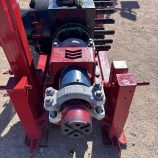Well Intervention: Tech Advancements in Reservoir Recovery

Posted: January 16, 2024
The oil and gas industry is relentlessly propelled by a pursuit for higher production at lower costs. In this pursuit, the sector is embracing new technologies and methodologies. This is especially true in the realm of well intervention, a critical process in well lifecycle management. As existing fields mature and new challenges arise, the ability to extend the life of a well, enhance its performance, and ensure its safe and economical operation is imperative.
In this article, we look at the innovative tools and processes that are transforming traditional practices. We’ll also consider the multidimensional impacts of these technologies, from enhancing production rates and maximizing recovery to ensuring safety and reducing costs.
We’ll share insights into how Gilmore is evolving to meet the demanding flow control needs of the sector while maintaining a steadfast commitment to operational excellence and sustainability.
Advancements in Well Intervention
New technological advancements in well intervention equipment and their components are enhancing efficiency. Innovative solutions in coiled tubing, hydraulic workover units, and intelligent completion systems allow for more precise control, real-time data analysis, and automation. This leads to safer and more cost-effective well maintenance and repair.
Well Intervention Operation Certainty
With improved certainty on well intervention processes, operators can better navigate timelines and estimate the needed resources and costs. More accurate budget and investment assessments help them determine the profitability and viability of the project.
Improvements in component design paired with data communication enable in-well visibility of equipment and component status. Autonomous well intervention solutions with sensor instrumentation have transformed wireline, slickline, and coiled tubing operations.
These real-time measurements enable operators to adapt to conditions that may be different from those expected. Operators can automate and augment conveyance, depth accuracy, and upcoming activities, allowing faster adjustments to ensure consistency and efficiency.
Operational Efficiency
Traditionally, a well intervention might require multiple runs in and out of the well, with each run dedicated to a specific task. But with advancements in technology and tool design, it’s possible to combine these tasks into one well trip.
This single run/multi-function approach significantly improves operational efficiency by reducing the time and cost associated with the intervention. It also minimizes the risk associated with multiple trips in and out of the wellbore, which is beneficial from a safety and environmental standpoint.
For example, a single tool or toolstring might be designed to perform a plug set, punch a hole in the pipe, and then cut the pipe, all in one descent into the well.
Tool integration, simultaneous task management, and single run/multi-function execution are quickly becoming the expected industry standard.
High-Performance Workover Production Solutions
With 60 years of flow control expertise behind us, we’ve witnessed considerable industry changes and market fluctuations. We’ve also been at the forefront of flow control innovation to address increasingly complex demands.
High-performance flow control components have become integral to ensuring efficient, safe, and cost-effective production while reducing environmental impacts. They also help increase maintenance intervals, maintain reliability in harsh conditions, and improve precision. This can result in a significant reduction in the time and resources required during a well intervention.
Through careful engineering and thorough testing at every stage, Gilmore released the high-performance GEN2 component series. We re-engineered flow control components specifically to improve previous designs. For instance, the GEN2 Regulator features tungsten carbide shear seals and hydraulic damping for a highly resilient, debris-tolerant, maintenance-free valve.
In addition, the tungsten carbide shear seals are precision lapped. This enhances seal resilience and provides a wiping action that resists leaking and contamination and protects both equipment and hydraulic functions.
Enhanced Control Flow Solutions for Well Intervention
When selecting well intervention equipment, it’s essential to consider design versatility for a variety of conditions. Using components engineered with modular and adaptable technology across systems improves efficiency by streamlining system integration testing (SIT).
Gilmore designs products that work on a variety of topside and subsea control systems, both regionally and globally. This experience also provides reliable, tailored flow control solutions for advancements in well interventions.
½” GEN2 SPMs
The Gilmore subplate-mounted (SPM) valves feature a bidirectional cartridge that offers improved seal resiliency, reduced pressure spikes, and lowered shift interflow. The valves deliver on/off high flow capacity in hydraulic control systems and are available in single or manifold options.
¼” GEN2 Disc Shuttle Valves
These compact resilient soft seal valves feature patented disc seal geometry, which Gilmore has thoroughly cycle tested at full MAWP (5,000 psi) with 8 GPM flow. The valves are available in spring-biased, low, and high interflow options. They’re also ideally suited to provide redundancy in the actuation of larger components and pilot circuits.
½” GEN2 Check Valves
Gilmore’s guided Nitronic 60 poppet-style check design provides one-way flow protection using Elgiloy spring for reliable resealing. Gilmore also offers pilot-operated check valves (POCV) with the ability to pilot the check open when reverse flow is required.
½” Mark IV Shuttle Valves
The Mark IV Shuttle Valves are available in low and high interflow and drag options as well as spring- and pressure-biased adapters for remote actuation. These high-performance components feature pressure ranges up to 6,000 psi, improved metal-to-metal seals, and cycle life to meet the demand of five years. They’re also available in custom configurations to fit specific operator applications in a well intervention.
¼” GEN2 Variable Pilot Valves
Gilmore’s rapid-reacting pilot valves protect equipment from abnormal flow-line pressure. They’re adjustable to function as normally closed or normally open, controlling both pneumatic and hydraulic systems.
Manifold assemblies use a pair of these valves to monitor flow line pressure. When a high or low limit is sensed, the assembly blocks control pressure to safely shut down the system.
Well Intervention Solutions Simplified
With smarter processes and innovation, well intervention techniques and technology drive increased production efficiency, safety, and cost-effectiveness. Gilmore’s advanced production solutions offer increased durability and reliability and lead to fewer maintenance cycles.
To further address industry challenges, Gilmore secures the availability of components through strategic spares strategies. What’s more, an adaptable design ensures their use in multiple applications. Whether you need a customized solution or standard flow control products to boost productivity, maintain safety, and reduce operational costs, we can help. Let’s chat.




